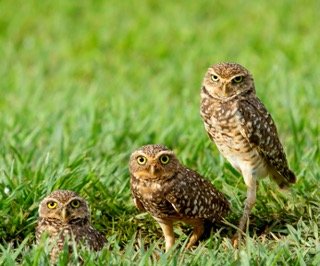
Owls in Florida
When I see an owl, I get a thrill out of it because they are such a well-known species. Their prey includes tiny mammals, as well as snakes, frogs, and insects. They are superb birds of prey that seek and consume small mammals as well as other small animals.
In most cases, owls consume their food whole, frequently after removing the head, and then vomit the bones and fur as waste. The Great Horned Owls are the largest owls in Florida, and the Burrowing Owls are the smallest owls in the state of Florida.
If you want to see owls in Florida, go to a wooded area at sunrise or sunset for the best chance of spotting them. Alternatively, to locate the burrowing owl, head to open ground; but, because to their small size, they may be more difficult to locate than you believe.
According to the World Bird Database and the Florida Ornithological Society, there are six regular species of owl and one accidental species of owl that have been observed in Florida.
A total of seven different species of Florida owl have had confirmed sightings in the last ten years, six of which are regular species and one of which is an accidental species. Because the number of sightings is so low, I haven’t included any of the other owl species that are regarded to be “accidental visits.”
Baby owls are adorable, and you should learn more about them if you haven’t already. Continue reading to learn more about the Owls of Florida and their habitat. In Florida, there are seven different types of owls:
- Barn Owl
- Eastern-screech Owl
- Great Horned Owl
- Barred Owl
- Short-eared Owl
- Burrowing Owl
- Snowy Owl
The 7 Species of Owl found in Florida are listed below:
1. Barn Owl
Barn Owls can be spotted all year in Florida, and they can be found all around the state. They do not migrate in any way.
- Length: 12.6-15.8 in (32-40 cm)
- Weight: 14.1-24.7 oz (400-700 g)
- Wingspan: ranges from 39.4-49.2 in (100-125 cm)

Barn Owls have white faces, chests, and bellies, as well as white underwings, and their backs are buff in hue. Their faces are round, and they have long, rounded wings and short tails. Females have spots on their chests that assist to keep parasites at bay, and the more spots the female has, the more the male contributes to the nest’s construction!
In the evenings, they forage for small rodents over open land such as fields and meadows, earning the name “barn owl” since they frequently roost in barns during the day. Barn owls swallow their prey whole and cough out pellets twice a day, according to the National Wildlife Federation.
Listen Barn Owl Hoot
Credit: Manceau Lionel, XC659876. Accessible at www.xeno-canto.org/659876.
Because the Barn Owl has the finest hearing of any animal studied, it mostly hunts for prey by listening for sounds. This allows them to seize prey in complete darkness or when it is hidden beneath plants or in a show of strength.
They make their nests in tree cavities, caves, and, more frequently, barns or other abandoned or quiet structures. Nest composed of regurgitated pellets that have been organized into a cup with the help of their feet.
Where I Can Find Owls? Everything You Need To Know
They lay between 2 and 18 white eggs throughout the course of one to three broods. Barn Owls are found on all six continents and are represented by around 46 different species. They don’t hoot like other owls, instead emitting a scratchy screech call as a substitute.
2. Eastern Screech Owl
In Florida, the Eastern Screech-Owl can be seen throughout the year.
- Length: 6.3-9.8 in (16-25 cm)
- Weight: 4.3-8.6 oz (121-244 g)
- Wingspan: 18.9-24.0 in (48-61 cm)
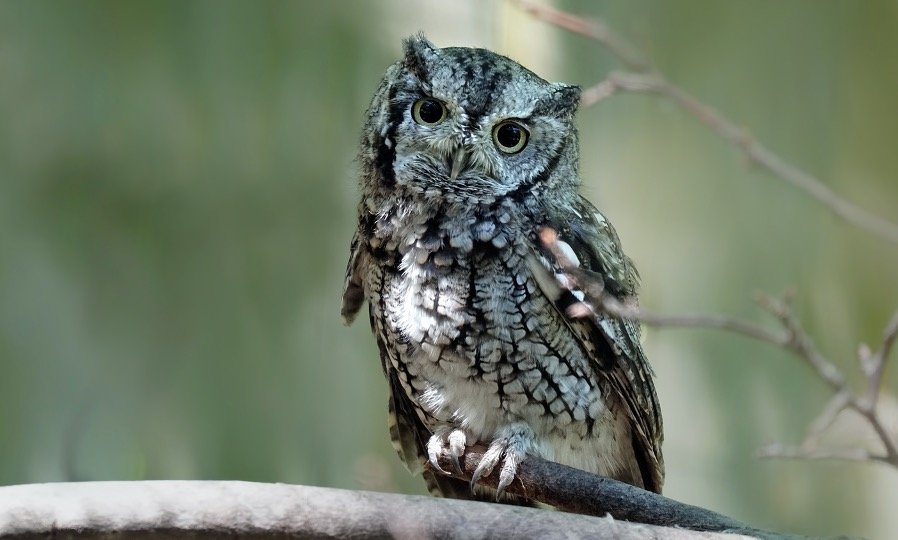
It is available in grey and red colorings for this short, stocky bird. They have a huge head and nearly no neck, and they are roughly the size of a robin, but they are much larger and thicker. Because of their patterned and spotted camouflage, they are difficult to detect against tree bark.
It is possible to see an Eastern Screech-Owl sunning itself in a tree cavity on cold sunny days or by the frenzied mobbing of songbirds when they come across one while they are in a wooded area. A pile of pellets can also be used as a telltale sign.
Listen Eastern Screech Owl Hoot
Credit: Lance A. M. Benner, XC513355. Accessible at www.xeno-canto.org/513355.
An eerie whinny sound descends in pitch and a vibrating trill is produced by these birds. Eastern Screech-Owls hunt primarily at night, but they also hunt during the day at dawn and dusk. They prey on a wide variety of tiny creatures, including birds, mammals, insects, reptiles, and amphibians.
They frequently perch on high perches and wait for prey to pass by before pounce. Because they seldom dig their own nests, the Eastern Screech-Owl frequently takes advantage of abandoned woodpecker nests or other holes and cavities.
5 Simple & Proven Ways To Attract Owls To Your Yard
In lieu of adding nesting material, they deposit their eggs on whatever trash is at the bottom of the cavity, which is usually leaves from previous nesting. They lay between 2 and 6 whitish eggs.
3. Great Horned Owl
The Great Horned Owl can be seen all year in Florida and throughout North America, including the Arctic. They are huge owls with thick bodies and large tufts of feathers on their forehead that resemble ear tufts.
- Length: 18.1-24.8 in (46-63 cm)
- Weight: 32.1-88.2 oz (910-2500 g)
- Wingspan: 39.8-57.1 in (101-145 cm)

They are gray-brown in color, with a mottled pattern on the back of their heads and a white patch on the throat. They have broad, rounded wings and a powerful hooting sound, which distinguishes them from other birds.
It is one of the most abundant owls in North America, and it may be found in a wide range of habitats, from woods to deserts, towns, and grasslands, among other places. For these fearsome hunters, prey includes birds and mammals that are much larger than they are themselves.
Listen Great Horned Owl Hoot
Credit: Lance A. M. Benner, XC545009. Accessible at www.xeno-canto.org/545009.
They will also hunt other raptors, such as ospreys, peregrine falcons, and other owls, if the opportunity presents itself. Its varied food includes tiny rodents such as mice or skunks, as well as birds of prey such as geese and hares.
It also contains insects, fish, and carrion. They are not picky eaters and will consume practically anything! Great Horned Owls build their nests in trees, and they frequently use an abandoned nest from another species.
15 Cutest Owls In The World
They sometimes line their nests with bark, leaves, downy feathers, or pellets, although they also leave them unlined on occasion. They lay 1-4 white eggs per clutch.
4. Barred Owl
In Florida, the Barred Owl can be found throughout the year. They are the owl species that can be found the most frequently in Florida. These huge, stocky birds are between the proportions of a crow and a goose in terms of stature.
- Length: 16.9-19.7 in (43-50 cm)
- Weight: 16.6-37.0 oz (470-1050 g)
- Wingspan: 39.0-43.3 in (99-110 cm)

Barred Owls are brown and white in color, with a mottled pattern of vertical stripes on their bellies and horizontal stripes on their backs and upper breast that is distinctive. These cats have black eyes, a characteristic round head with no ears, and an oval-shaped tail that is slightly curled at the end.
Listen Barred Owl Hoot
Credit: wisconagus, XC691476. Accessible at www.xeno-canto.org/691476.
The Barred Owl communicates by making a loud barking hoo hoo call. Their method of hunting for small animals, such as squirrels and rabbits as well as birds and voles, is to sit and watch from an elevated perch.
They dwell in huge, mature forests, frequently near bodies of water, and build their nests in tree cavities, where they deposit 1-5 white eggs per clutch.
5. Short-eared Owl
The Short-eared Owl is primarily found in Florida throughout the winter months, with some individuals remaining there until June before moving to further northern states and Canada for nesting. Approximately the size of a crow, they have extremely little ear tufts and are medium-sized in overall appearance.
- Length: 13.4-16.9 in (34-43 cm)
- Weight: 7.3-16.8 oz (206-475 g)
- Wingspan: 33.5-40.5 in (85-103 cm)
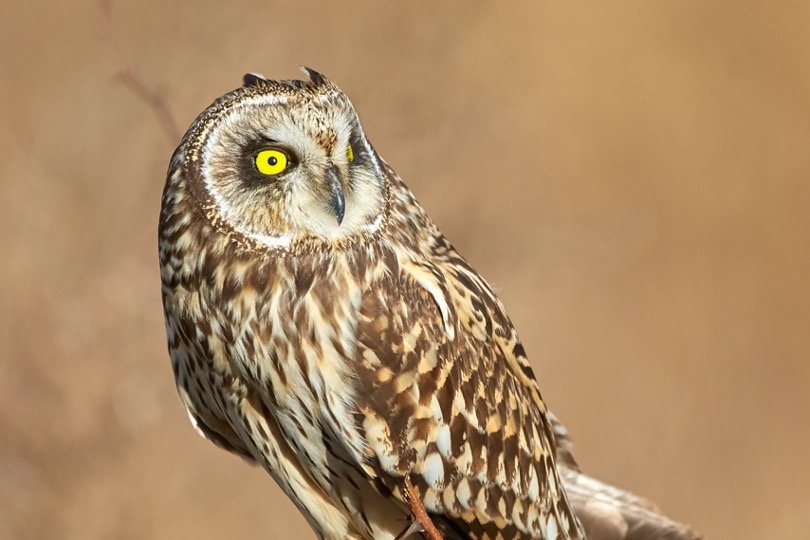
Short-eared Owls are distinguished by their mottled black, brown, and white colouring, as well as their pale cheeks and black-rimmed yellow eyes. A short tail is attached to the end of their large wings, which have a rounded tip.
The Short-eared Owl, in contrast to most other owls, hunts during the day, primarily around dawn and dusk. It is their prey, small mammals such as voles and mice, that they hunt, and they fly low over the ground, searching and listening for movement.
Listen Short-eared Owl Hoot
Credit: Romuald Mikusek, XC669188. Accessible at www.xeno-canto.org/669188.
It is also noteworthy that short-eared owls construct their own nests by scraping the ground into a bowl and lining it with grass and soft feathers. They lay between 1 and 11 cream or white eggs per clutch.
Sleeping Owls Are So Adorable: Pictures & Fun Fact
They are not extremely loud, although the males will produce approximately a dozen hoots during courtship, and when guarding the nest, they may bark, whine, or scream to get the female’s attention.
6. Burrowing Owl
Burrowing Owls can be spotted throughout the year in Florida, with the majority of sightings occurring in the southern half of the state. Because they hunt on the ground during the day and sprint around on their long legs, Burrowing Owls are unique in that they dwell below in burrows and hunt on the ground at night.
- Length: 7.5-9.8 in (19-25 cm)
- Weight: 5.3 oz (150 g)
- Wingspan: 21.6 in (55 cm)
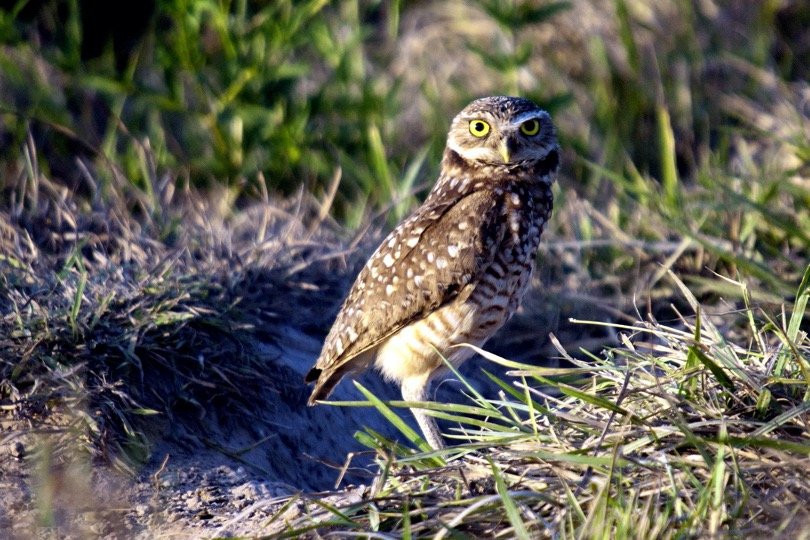
Due to the fact that owls appear to have flatter heads and are missing the face disc and ear tufts that some owls have, they appear to have a strange look. Adults are mottled brown and white, with yellow bills and eyes, and have yellow bills and eyes.
The undersides of their backs are paler than the tops of their heads. Juveniles have less mottled spots. Breeding in western states of the United States and southern Canada before moving south to Mexico and Central America to reproduce.
Listen Burrowing Owl Hoot
Credit: David Ricardo Rodríguez-Villamil, XC524491. Accessible at www.xeno-canto.org/524491.
Those in the southwestern United States, Florida, and northern Mexico remain throughout the year. They can be found in open places with low vegetation and grassland, mainly where prairie dogs or other burrowing animals live, as they live in old burrows.
They are most commonly found in prairie dogs or other burrowing species’ burrows. Due to the fact that burrowing owls are small and well disguised, they are far more difficult to notice than you would think in the open.
The Burrowing Owl’s diet consists primarily of lizards, birds, mammals, and insects. Females are more likely to hunt insects during the day, while males are more likely to seek lizards, mice, and voles during the night.
6 Largest Owls In The World: Everything You Need To Know
Ingeniously, they transport animal excrement to their burrows, where it attracts beetles and insects, which they then prey on. They will keep any leftover kills in their burrows, which can be a significant amount (and, I think, pretty nasty!). They build their nests in ancient burrows, and they will often sleep on a dirt mound near the entrance of the burrow.
7. Snowy Owl
Snowy Owls are considered an incidental species of owl in Florida, as they were not introduced there intentionally. They have, on the other hand, been observed in Florida during extreme irruptive years when lemming populations in Canada are low. They were last observed in Florida in 2013 and 2014, in the vicinity of the city of Jacksonville.
- Length: 20.5-27.9 in (52-71 cm)
- Weight: 56.4-104.1 oz (1600-2950 g)
- Wingspan: 49.6-57.1 in (126-145 cm)
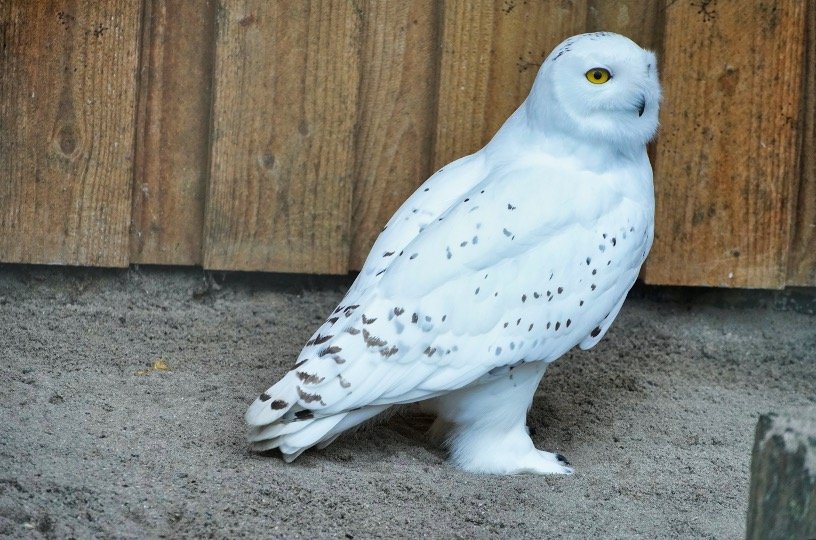
In appearance, they are a unique white bird with modest quantities of black or brown patterns. They have golden eyes and are roughly the size of crows in size. In icy conditions, they can be difficult to distinguish, but they prefer to congregate on ridges and crests, which makes them simpler to identify.
They are typically deafeningly quiet, but during breeding season they may emit a harsh croak or shrill whistle. Snowy Owls, in contrast to other owls, are diurnal, meaning they hunt in the arctic during the 24-hour summer sunshine.
Listen Snowy Owl Hoot
Credit: Petr Suvorov, XC219348. Accessible at www.xeno-canto.org/219348.
They prey on small mammals, particularly lemmings, and can consume up to 1600 of them in a year. They also catch birds in flight, such as ptarmigans and ducks, which they release back into the wild.
Rodents such as rabbits and squirrels, as well as birds such as ducks and geese, will be eaten during the winter months. The snowy owl is a wandering species that seldom breeds in the same site or with the same mates on an annual basis, and it may not reproduce at all if prey is in short supply during breeding season.
Where Do Owls Nest? Everything You Need To Know
On the tundra, the Snowy Owl’s nest is nothing more than a shallow hole dug into the earth. They choose a windswept ridge that will be blown clear of snow, and they plan to reuse the nest for a number of years. They lay 3-11 whitish eggs per clutch.



